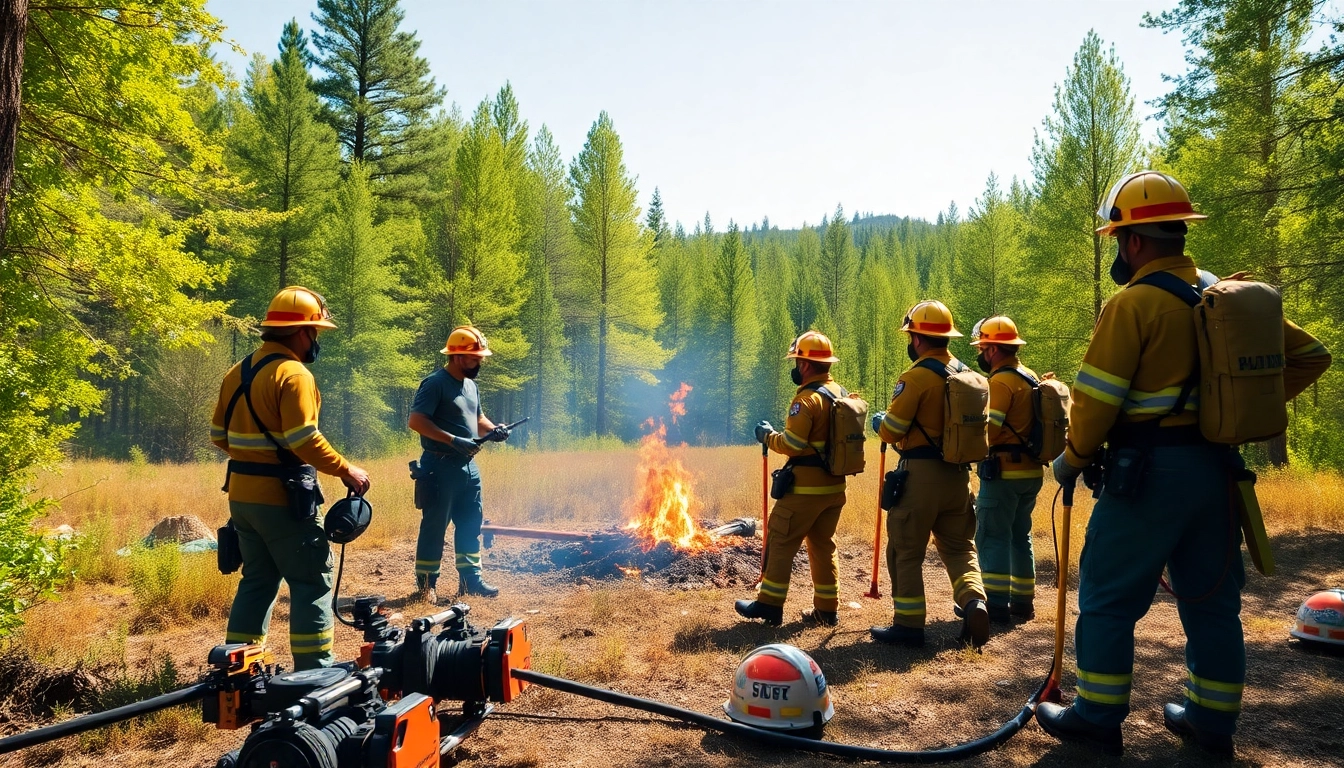Understanding Wildfire Events: Causes and Impact
What are Wildfire Events?
Wildfire events are uncontrolled fires that ignite in natural areas, primarily affecting forests, grasslands, and prairies. These phenomena can vary in size, intensity, and duration, leading to damage not only to the environment but also to human infrastructure and public health. Defined by their rampant spread and destruction, wildfire events result from a combination of natural and anthropogenic factors. With ongoing climate change driving shifts in weather patterns, the frequency and severity of these events have escalated, posing increasing risks to ecosystems and communities alike. For further insights into the scope and impact of wildfire events, explore this resource: wildfire events.
Environmental Factors Influencing Wildfire Events
Various environmental factors contribute to the ignition and spread of wildfire events. One key element is weather, particularly temperature, humidity, and wind speed, which dictate the fire’s behavior. Prolonged periods of drought create favorable conditions for wildfires, as dry vegetation is more susceptible to burning. Additionally, the type of vegetation, its moisture content, and overall ecosystem health can significantly influence fire activity. For instance, dense forests with a lot of dead wood are often at higher risk compared to managed areas that have been thinned and maintained.
Geographical factors also play a role, as certain regions, such as mountainous areas or those with steep slopes, can facilitate faster fire spread due to wind patterns that are intensified by the terrain. Lastly, human activities, such as urban encroachment into wildland areas, agricultural practices, and land management techniques, can increase the chance of fire starts and the complexity of fire containment efforts.
Consequences of Unmanaged Wildfire Events
The consequences of unmanaged wildfire events can be devastating. Ecologically, wildfires can lead to habitat destruction, loss of biodiversity, and the disruption of ecological balance. Soil erosion becomes a significant issue as protective vegetation is stripped away, making land more susceptible to degradation.
Economically, the cost associated with wildfire events can be staggering. Billions are spent annually on firefighting responses, recovery, and property reconstruction. The fallout extends to local and regional economies that rely on tourism and agriculture, as landscapes alter drastically post-fire. Additionally, public health can be significantly impacted due to the smoke produced by wildfires, which can exacerbate respiratory issues and other health risks.
Preparation Strategies for Wildfire Events
Creating a Community Preparedness Plan
Research shows that community preparedness plans are integral to minimizing the impact of wildfire events. Such plans should involve local authorities, community organizations, and residents to ensure comprehensive coverage and understanding of risks. A successful community preparedness plan involves several steps:
- Identifying Risks: Understanding which areas are most vulnerable to wildfires based on historical data and environmental assessments is crucial.
- Developing Evacuation Routes: Clear, well-communicated evacuation routes can save lives. Signs should be prominently placed and routes should be tested.
- Engaging the Community: Conduct community workshops and drills to ensure everyone knows what to do before, during, and after a wildfire event.
- Establishing Communication Plans: Use platforms that facilitate quick dissemination of crucial information, including local radio, social media, and emergency alerts.
Risk Assessment and Mapping Fire-Prone Areas
Risk assessment is a vital part of wildfire preparedness. It involves evaluating local landscape features, historical fire activity, and current land-use practices. Geographic Information Systems (GIS) can be utilized to create detailed maps indicating areas at high risk for wildfires, enabling targeted mitigation strategies. Communities can better allocate resources to defend against wildfires by understanding fire-prone areas. Additionally, implementing buffer zones, firebreaks, and controlled burns in high-risk zones can significantly reduce potential impacts.
Education and Awareness Initiatives for Wildfire Events
Education plays a pivotal role in wildfire management. Awareness campaigns that inform residents about wildfire risks and safety practices help cultivate a culture of preparedness. Such initiatives might include educational programs in schools, community workshops, and partnerships with local environmental agencies. Evidence suggests that informed communities are better prepared to mitigate wildfire risks proactively.
Effective Response Tactics for Wildfire Events
Emergency Response Framework
An effective emergency response framework is critical during wildfire events. This framework encompasses a combination of immediate response protocols, inter-agency collaborations, and resource deployment strategies. Adequately trained personnel must remain in readiness, with defined roles for firefighters, support staff, and community volunteers.
Incorporating real-time data from satellites and ground-based sources can enhance situational awareness and inform actionable decisions on the ground. Establishing a command center with communication capabilities ensures seamless coordination between firefighting teams and emergency responders.
Utilizing Technology in Wildfire Management
The role of technology in wildfire management continues to grow in importance. Innovations like drone surveillance provide up-to-date information about fire behavior, enabling better decision-making in containment efforts. Moreover, predictive modeling software uses historical data and real-time information to simulate fire dynamics, helping to identify potential spread patterns and areas at risk.
Advanced communication technology also plays a critical role. Mobile alerts and social media platforms can disseminate timely warnings to residents, allowing for swift evacuations and protective actions.
Collaboration with Local Agencies During Wildfire Events
Collaboration among local, state, and federal agencies is essential when contending with wildfires. Joint exercises and training sessions can enhance mutual understanding of operational protocols, ensuring all entities work seamlessly together during an active fire event. Coordination with agencies such as emergency services, land management agencies, and environmental groups can provide access to diverse resources and expertise, improving overall effectiveness in managing wildfire events.
Innovative Approaches to Mitigate Wildfire Events
Firebreaks and Controlled Burns
Firebreaks and controlled burns are two innovative approaches that play a significant role in wildfire mitigation. Firebreaks, which are cleared areas devoid of vegetation, serve as barriers to slow or stop the spread of fire. Proper planning and maintenance of firebreaks can be lifesaving during an active fire, but they must be strategically placed based on fire behavior and topography.
Controlled burns, also known as prescribed fires, involve intentionally setting fires under controlled conditions to reduce fuel loads in high-risk areas. This technique has gained acceptance within fire management circles for its effectiveness in fostering healthier ecosystems while reducing the likelihood of catastrophic wildfires.
Wildfire-Resistant Landscapes and Ecosystems
Creating wildfire-resistant landscapes involves a holistic approach to land management that considers the ecological role of fire. This approach emphasizes the selection of fire-resistant plants in landscaping and maintaining proper spacing between trees to reduce fire intensity. By designing resilient ecosystems, we can promote biodiversity while minimizing the risk and impact of wildfire events.
Community Involvement in Wildfire Mitigation Efforts
Community involvement is crucial in wildfire mitigation efforts. Empowering residents to participate in creating defensible spaces, utilizing fire-resistant landscaping, and engaging in localized preparedness activities fosters a sense of ownership over fire safety in their communities. Outreach programs that gather community members for workshops on wildfire prevention and preparedness can enhance awareness and proactive behavior among residents.
Evaluating and Adapting to Wildfire Events
Post-Wildfire Assessment Procedures
Post-wildfire assessments are essential for understanding the extent of damage and effectiveness of response strategies. Conducting thorough evaluations helps identify what went well and what could be improved for future wildfire events. This process involves analyzing ecological damage, reviewing community response effectiveness, and considering the economic repercussions stemming from the wildfire.
Implementing Lessons Learned from Past Wildfire Events
Learning from past wildfire events is vital to improving future preparedness and response strategies. Documenting case studies allows stakeholders to examine what worked and what didn’t, leading to the evolution of best practices in wildfire management. Integrating these lessons into community planning and training ensures that valuable insights contribute to building a more resilient community.
Future Trends in Wildfire Management
As the landscape of wildfire management continues to change, embracing new trends becomes paramount. Emerging technologies such as machine learning and artificial intelligence are expected to enhance predictive modeling and risk assessments, leading to more effective wildfire management. Furthermore, policies focused on climate adaptation will become increasingly essential as we confront the impacts of climate change on wildfire frequency and severity.
In conclusion, addressing wildfire events requires a comprehensive and multifaceted approach that encompasses prevention, preparedness, response, and recovery. By fostering collaboration, investing in technology, and engaging communities, we can mitigate the risks associated with wildfire events and work toward a safer, more sustainable future.













Leave a Reply